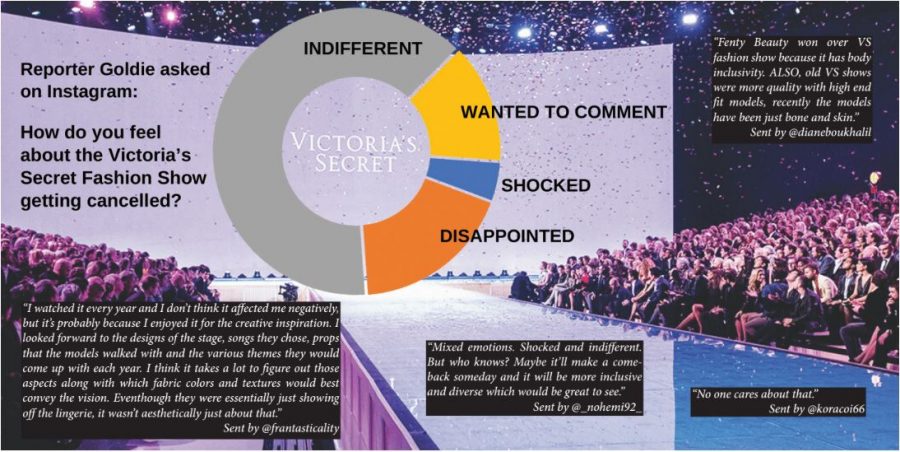No Angels here: Victoria’s Secret is out
December 3, 2019
You might have heard of the famous Victoria’s Secret that is televised annually, with past performances by artists such as Taylor Swift, The Weeknd, Ariana Grande, Fall Out Boy and Halsey. This year has taken a different turn. The Victoria’s Secret brand, known for its glamorous fashion shows, style and lace/sultry aesthetic, has been canceled.
According to Thevox.com, CEO Les Wexner told employees in an internal memo that the company has decided to rethink the traditional Victoria’s Secret fashion show. Wexner also added, “going forward, we don’t believe network television is the right fit.”
The Victoria’s Secret Fashion Show has aired annually on ABC. It was first introduced by Stephanie Seymour and it was held at the Plaza Hotel in New York City in Aug. 1995. Some people may be more excited than others to watch the show because they either enjoy watching the VS Angels catwalking in bedazzled lingerie or they want to see who will be that year’s celebrity performer.
I remember when Taylor Swift performed at the fashion show in 2013; I watched it because I both wanted to see Swift perform and to see what the fashion show is all about. The models looked the same to me–tall, toned figures strutting down the runway. However, their height and Victoria’s Secret-clad figures were the highlights of the fashion show. Victoria’s Secret’s message is clear: that women should look like this in order to wear lingerie or workout gear.
As LZ Granderson of CNN.com expressed, “Victoria’s Secret’s strict definition of female beauty—thin, bosomy, unattainable—is not only outdated, it was never accurate to begin with. Beauty is truly in the eye of the beholder.”
Granderson points out that Victoria’s Secret’s beauty standard is “unattainable” and some women’s biological characteristics disqualify them from adhering to Victoria’s Secret’s standard of beauty. You are born with what you have, but women and those who identify as women seek ways to look better by altering their bodies, faces and hair.
The promotion of a standardized beauty model is a rejection of body inclusivity. It is no wonder that Dove’s Real Beauty campaign is the counterpart to every Victoria’s Secret campaign and has been more readily embraced by today’s younger generation.
The majority of women do not look like a Victoria’s Secret model. There are so many body types and sizes in society that by enforcing a certain beauty standard is definitely discouraging. It is and can be discouraging because some impressionable young women and those who identify as women could compare themselves to models and negative thoughts can arise rather than accepting their own body or focusing on inner beauty.
Halsey, a member of the LGBTQ+ community that performed on the show in 2018, called out Victoria’s Secret after Chief Marketing Officer Ed Razek said that they
did not want to include transgender models “because the show is fantasy.”
In other words, Razek is saying that in the fantasy world of Victoria’s Secret, only thin, tall models exist. Furthermore, models of color are severely underrepresented. They have exotic-looking models, but the majority are individuals of Caucasian descent who identify as female.
Maybe it is just as simple as Victoria’s Secret being one of the many bricks-and-mortar with plummeting sales due to e-commerce, which has been an issue in the past few years. But surely it wouldn’t have hurt to include some diversity and inclusivity into their marketing campaigns in order to remain relevant to the next generation.
It is truly astonishing that in 2019, inclusivity and marginalization is still so commonplace in the world of the VS Angels. Perhaps, this is only a hiatus for them to come up with a new secret.








